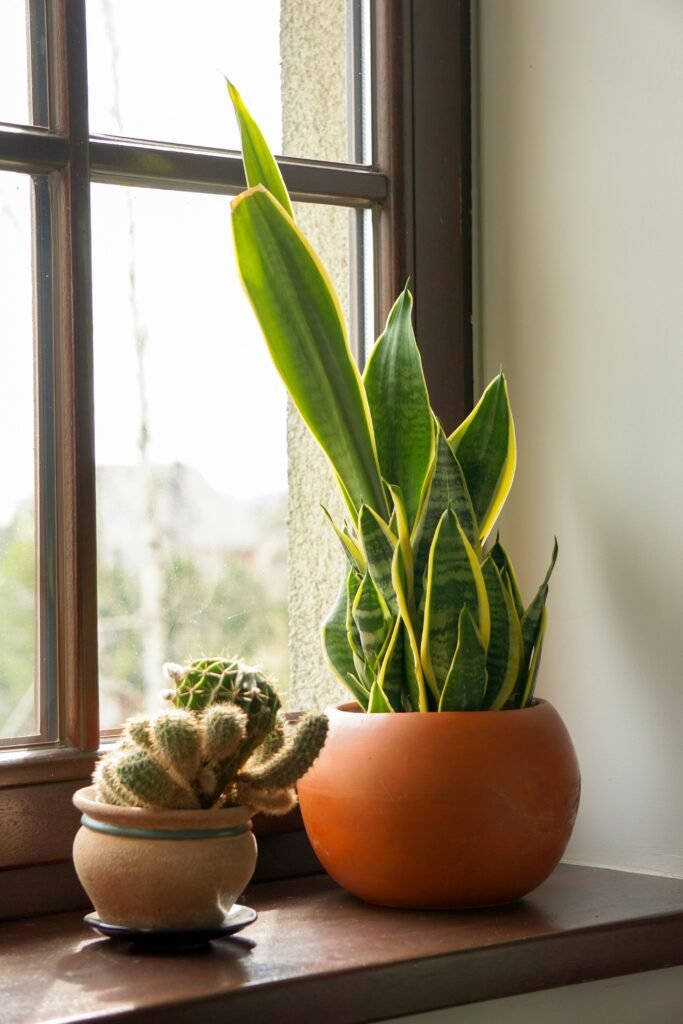This is a low-maintenance houseplant that has many cultivars. Snake plants (Dracaena trifasciata) are one of the most popular houseplants for easy care and propagation. They can adapt to low-light conditions and underwater. This plant is recognized for its broad, elongated, leathery leaves, which double as decor.
How To Care For A Snake Plant

Photo by Ala J Graczyk
Most snake plants are purchased from a nursery as potted plants rather than grown from seed.
Sunlight
Snake plants (Dracaena trifasciata) prefer indirect sunlight or direct sunlight for some hours, like four to five. They can adapt to low light, but if placed in low light, their photosynthesis decreases, which in turn affects their growth.
Water
Water your snake plants (Dracaena trifasciata) once every two weeks. They can adapt to low water but not to overwatering. As a beginner, I made the same mistake. Overwatering causes fungal infections.
Soil
Your snake plants (Dracaena trifasciata) should be potted in a container with well-draining soil. They prefer a loose potting soil mix, often sandy soil, making all-purpose cactus potting soil a good choice.
Fertilizer
Feed your snake plant once in spring and once in mid-summer with a balanced, slow-release 10-10-10 fertilizer. Do not fertilize in winter.
How To Propagate A Snake Plant
The best time to propagate your snake plant is in spring and summer. You can propagate it in two ways: by cutting or division when plants are at least 4-5 inches tall.
Tools And Equipment Needed
To propagate your plant, you’ll need some tools to make it smooth and easy:
· A Sharp knife
· A clean and empty pot
· Fresh, well-draining potting mix
Once you have collected these tools, you are ready to propagate your snake plant. You can use a towel or some plastic to cover your workplace for easy and fast cleaning.
Tip:
Choose your workplace carefully. Don’t do it somewhere that the plant doesn’t like the environment. Always maintain a suitable home environment to avoid unnecessary stress on both parent plants and cuttings.
How To Propagate Snake Plant By Division
· Gather a sharp clean knife, a clean pot, and soil mix.
· Remove the plant from the pot and carefully divide it from the parent plant.
· Re-pot it with fresh soil mix, ensuring the plant’s roots go deep into the pot.
· Here, I made some mistakes: Don’t water it for at least 3-4 days to prevent overwatering.
· Place it in a sunny location. It can survive in low light and sunny locations, but try to keep it in a sunny location.
How To Propagate Snake Plant From Leaf Cutting
· Use a sharp cutting tool to remove a long and healthy leaf from the parent plant.
· Take the leaf and cut it at least 2-3 inches.
· Place them in a jar with clean water and cover the opening with plastic.
· Place it in a sunny area, usually beside a window or in indirect sunlight. Direct sunlight is not ideal.
· Change the water weekly to provide the snake plant with more oxygen.
· Roots will develop in 1-4 months. Once they reach one inch long, plant them in a pot with soil mix and place them in a sunny location.
Pruning
I prune snake plants (Dracaena Trifasciata) during the growing season to encourage new growth. To control height, remove the tallest leaves at the soil line. Winter pruning can cause stress.
Tips
Always keep your snake plant leaves clean because dust decreases photosynthesis, reducing its air purifying abilities.
Potting And Repotting Snake Plant
Re-pot your snake plant every 3-5 years or when you see roots growing out of the holes. Other signs that your plant needs repotting are water draining too quickly. Snake plants love small pots with good drainage. The pot size should be about twice the size of the roots.
How To Get Snake Plant To Bloom
Giving your plant enough sunlight and allowing it to become rootbound can encourage your snake plant to bloom indoors.
Common Pests problem
Snake plants are susceptible to common houseplant pests such as scales, gnats, and spider mites. Most can be removed by hand or with a gentle spray of water.
Common Problems With Snake Plants
Snake plants are easy to maintain and can last for many years. They also work as air purifiers, adding beauty to your home. The most common problems for snake plants are overwatering and underwatering, which can cause fungal infections.
Leaves Falling Over or Dropping
Snake plants grow upward and stand strongly, but too much water, insufficient light, or poor potting mix can cause leaves to droop or flop over.
Benefits Of Snake Plants
· Easy to care for and a great plant for beginners
· Unique shapes add height and interest to houseplant collections
· Adapts to different light conditions
· Works as an air purifier
FAQ
Why is it called a snake plant?
The long, thin leaves with distinct stripes resemble some types of snakes.
How fast does a snake plant grow?
Snake plants are slow growers.
How long does a snake plant live?
The average lifespan of a snake plant is five to ten years, but they can live up to 25 years or more.



